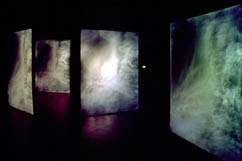
|
| Technical Details: 2 projectors,
4 projection screen, 2 mirrors, 2 laser discs, 1 disctator |
|
The Vasulkas Inc. stands for the married couple Steina & Woody Vasulka, artists who, in the world of media art and electronic music, have been well-known for more than 30 years - they are the founders of the famous New York Media Theater "The Kitchen" - and are still breaking new ground in these fields. As true pioneers in the area of the electronic media, they design and construct their own machines, such as the Vasulka Imaging System and the Digital Image Articulator, with which, in particular, they investigate the intrinsic characteristics of electronic image and sound, and explore the space 'behind' the lens and the microphone.
The Vasulkas not only make art together, but, during the course of time, have also built up substantial individual oeuvres, with their own characteristics of form and content. Steina Vasulka is more interested in the optical aspects of the electronic image and the visualization of a 'total space'. Her musical background - she was originally trained to be a violinist at the Music Conservatory in Prague - combined with her fascination for the natural landscape, has to a large extent determined the aesthetics and conceptual intentions of her video work.
For Voice Windows (1986), an interactive vocal and video work, Steina worked together with the composer and media artist Joan de la Barbara. Thanks to an interactive system developed by the Vasulkas, De la Barbara's experiments with vocal techniques could be visualized as video images. In Voice Windows, the sound patterns influenced the images of moving landscapes created by Steina, and image and sound intertwined into an interactive unity.
Steina's installation Geomania (1989) was a pyramid of ten monitors showing images of landscapes and natural phenomena, such as geysers and volcanos, filmed in her native Iceland. Steina turned these rough, uncivilized geological images of nature into a dynamic and spatial collage, in which the rhythm of the montage ensured a contemplative alternating flow, full of symbolic and perceptual variations.
For Pyroglyphs (1994), twelve monitors were placed in a circle in a dark area: they showed close-ups of a glowing fire and sputtering sparks, filmed at a forge, and accompanied by an earthly concert of hammers, metal saws, welding apparatus and oxyacetylene cutters.
With Borealis, Steina created a 'magic environment' by means of four free-standing and vertically placed projection screens - each showing images on both sides - two video projectors, and an ingenious mirror system. The two mirror constructions duplicate the video projections, which are reflected onto the other screens. The images surrounding the viewer are close-ups of running water, seascapes from Iceland - occasionally you are also surprised by images of flowers. The images overwhelm you with their movement and their, technologically processed, sound. The water moves vertically and alternately forwards and backwards, by which Steina makes the endless, primaevally driven, flow of the natural movement of water take a different turn, and time a different direction. You become totally immersed in, and absorbed by, the rhythm of the images and the spatiality of Borealis. Because the only light in the room comes from the images themselves, there is virtually no 'outside world' to distract you, and you vanish temporarily into a space governed by its own order of space and time.
Jorinde Seijdel
|
|
